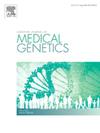cep85l相关无脑畸形的概述和扩展。
IF 1.7
4区 医学
Q3 GENETICS & HEREDITY
引用次数: 0
摘要
神经元迁移缺陷导致无脑畸形(LIS),这是一种神经发育障碍(NDD),大脑表面光滑,皮层厚度异常。CEP85L的变异与后显性LIS有关,但表型和基因型尚不清楚。三个新的不相关的病例cep85l相关的LIS提出,包括首次产前诊断和马赛克变体。记录临床、神经影像学和遗传分析。来自29个先前报告的个体的数据被用于全面的文献综述。使用人类表型本体(HPO)术语来注释表型特征,并使用美国医学遗传与基因组学学院(ACMG)指南来评估变异。所有的产后个体都有不同的NDD。总体发育迟缓占71%(22/31),言语或运动迟缓占54%(分别为11/31和6/31),智力残疾占74%(23/31)。90%(28/31)发生集中和全身性癫痫发作。脑磁共振成像(MRI)显示所有被评估个体的LIS以后显性为主,55%(17/31)的病例也表现为皮质下带异位(SBH)。在所有个体中共鉴定出18种不同的CEP85L变异,均聚集在氨基酸1 ~ 103之间高度保守的n端区域。其中包括10个错义突变,5个剪接位点改变,2个启动-丢失变体和1个停止变体。9个从头变异,10个父母变异,13个遗传未知的变异。cep85l相关LIS的基因型-表型相关性表明,较强的剪接和种系变异通常比花叶变异引起更严重的症状。为了减少由其他CEP85L转录本引起的混淆,我们推荐使用NM_001042475进行变体解释。这些发现改善了这种疾病的遗传诊断和咨询框架。本文章由计算机程序翻译,如有差异,请以英文原文为准。
Overview and expansion of CEP85L-associated lissencephaly
Defective neuronal migration causes lissencephaly (LIS), a neurodevelopmental disorder (NDD) with a smooth cerebral surface and abnormal cortical thickness. Variants in CEP85L are linked to posterior predominant LIS, but the phenotype and genotype are unclear. Three new unrelated cases of CEP85L-associated LIS are presented, including the first prenatal diagnosis and a mosaic variant. Clinical, neuroimaging, and genetic analyses were recorded. Data from 29 previously reported individuals was used in a comprehensive literature review. Human phenotype ontology (HPO) terms were used to annotate phenotypic features, and American College of Medical Genetics and Genomics (ACMG) guidelines were used to evaluate variants. All postnatal individuals had variable NDD. Global developmental delay was observed in 71 % (22/31), speech or motor delay in 54 % (11/31 and 6/31, respectively), and intellectual disability in 74 % (23/31) of cases. Focused and generalized-onset seizures occurred in 90 % (28/31). Brain magnetic resonance imaging (MRI) revealed predominantly posteriorly predominant LIS in all evaluated individuals, with 55 % (17/31) of cases also exhibiting subcortical band heterotopia (SBH). A total of 18 different CEP85L variants were identified among all individuals, all clustering in a highly conserved N-terminal region between amino acids 1 and 103. These included 10 missense mutations, five splice-site alterations, two start-loss variants, and one stop variant. Nine de novo variants, 10 mother-father variants, and 13 variants with unknown inheritance. Genotype-phenotype correlations in CEP85L-associated LIS show that stronger splice and germline variants often cause more severe symptoms than mosaic variants. To reduce confusion caused by alternative CEP85L transcripts, we recommend NM_001042475 for variant interpretation. These findings improve this disorder's genetic diagnostics and counseling framework.
求助全文
通过发布文献求助,成功后即可免费获取论文全文。
去求助
来源期刊
CiteScore
4.10
自引率
0.00%
发文量
193
审稿时长
66 days
期刊介绍:
The European Journal of Medical Genetics (EJMG) is a peer-reviewed journal that publishes articles in English on various aspects of human and medical genetics and of the genetics of experimental models.
Original clinical and experimental research articles, short clinical reports, review articles and letters to the editor are welcome on topics such as :
• Dysmorphology and syndrome delineation
• Molecular genetics and molecular cytogenetics of inherited disorders
• Clinical applications of genomics and nextgen sequencing technologies
• Syndromal cancer genetics
• Behavioral genetics
• Community genetics
• Fetal pathology and prenatal diagnosis
• Genetic counseling.

 求助内容:
求助内容: 应助结果提醒方式:
应助结果提醒方式:


